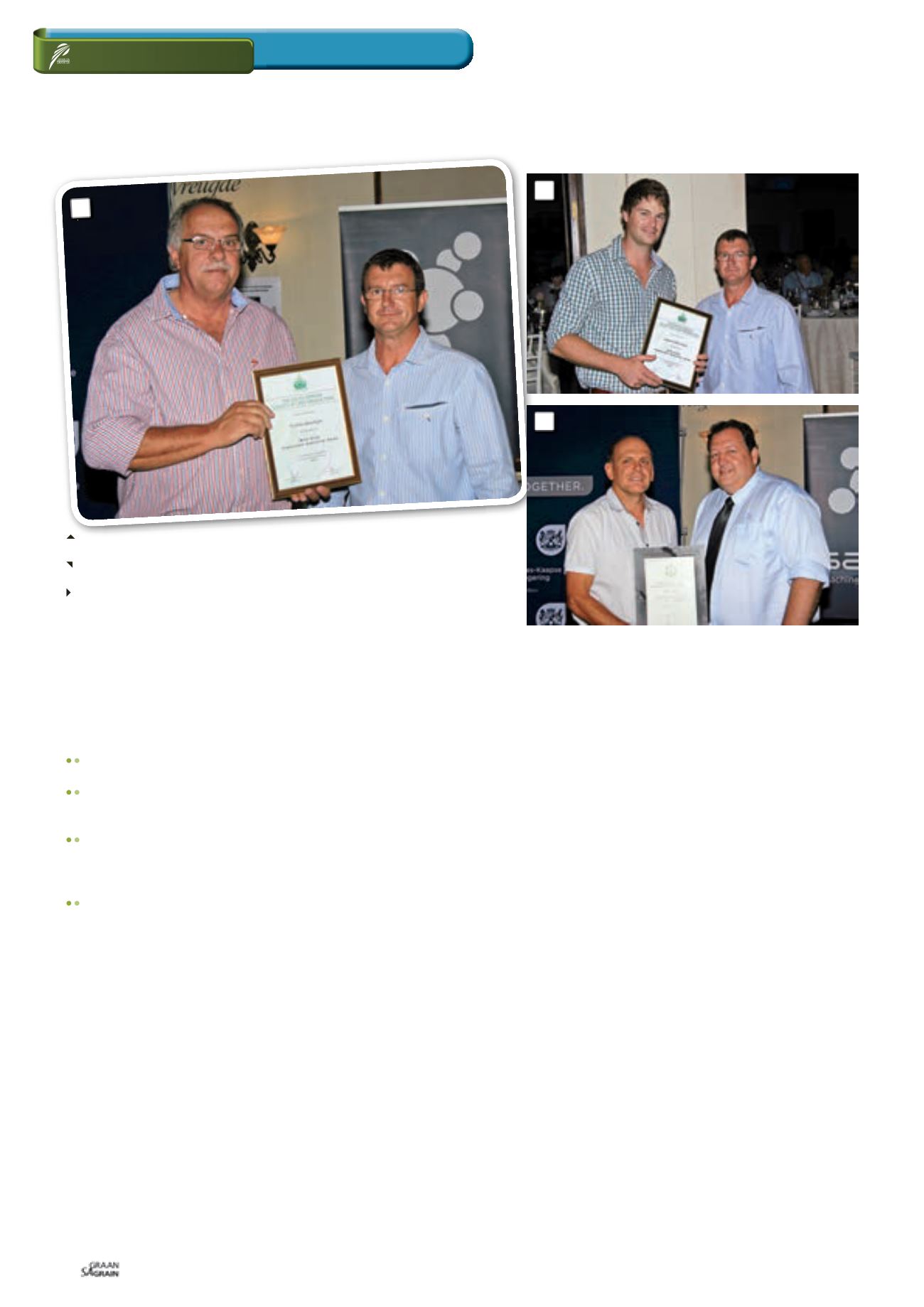

April 2015
80
RELEVANT
Using trial data from Langgewens research
farm near Moorreesburg, his study evalu-
ated a comparative analysis of the various
CA farming systems over an extended
period of time under varying sets of finan-
cial impacts, and came to the following
conclusions:
The monoculture system is not finan-
cially viable.
The impact of weed infestations due to
herbicide resistant ryegrass is unsus-
tainable.
The buffering effect of increased yields
derived from diversified crop rotations
reduced the farming system’s sensitiv-
ity to fluctuation in external factors.
No-till systems generate a higher ex-
pected internal rate of return (IRR) over
an extended period of time.
Le Roux’s MSc research was initiated due
to concerns from farmers in the Southern
Cape. The producers noticed a decrease
in annual medic pasture re-establishment
under CA practises and as a result shifted
away from medics as a pasture crop.
Le Roux studied the effect of increasing
residue left on the field as is set as one of
the cornerstones of CA. The study evalu-
ated medic re-establishment, establishment
and the production of the annual pasture
following different proceeding crops.
Included was five degrees of cover rang-
ing from 0% to 100% and included residues
from wheat, barley, oats and medics. From
the research it became clear that the best
re-establishment happens in wheat stubble.
Other crop residues might be allelopathic, in
the case of the other cereals, or auto-toxic,
as is the case with medic residues which
hampers the re-establishment.
The same scenario was found in the estab-
lishment of medic pastures. It also became
clear that there were no significant differ-
ences in ultimate production between the
0% and 75% residue cover, which is very
positive for retaining as much residue on
top of the soil as possible. It was evident
from his findings that in the Southern Cape
it might be advisable to replant medic pas-
tures at least every five to seven years, and
to manage it correctly, otherwise it might
be necessary to replant it much earlier to
ensure sustainable pasture production.
The five poster contributions included work
done on the carbon content, as one of the
major indicators of soil health, of different
cropping rotations and tillage practices that
form part of the long-term research trials at
Langgewens in the Swartland. In his post-
er, Mr Glen Cooper (soil science student)
showed systems that, including medic pas-
tures, tended to have higher levels of soil
organic carbon (SOC) than other systems
and that any form of tillage disturbance
of the soil caused lower levels of SOC.
These results are from the first year of his
MSc Agric.
Dr Strauss showed that short rotation sys-
tems can be viable when used in the South-
ern Cape. Short rotations that include medic
pastures rather than long-term lucerne and/
or systems consisting of cash crops only,
can be sustainably farmed in this area. The
results were obtained from the long-term
crop rotation trial at Tygerhoek.
Two posters by Mr Piet Lombard focused
on determining the optimal seeding density
for canola and hay crops, oats and triticale.
His preliminary investigation indicated that
a more in-depth study in canola is neces-
sary. It will include as many cultivars as pos-
sible, since the data suggests that we are
seeding at a rate of about 50% more than
is necessary.
Results from the hay study were inconclu-
sive. Also from the cultivar evaluation pro-
gramme, a poster by Miss Lisa Smorenburg
gave insight into potential cover crops and
combinations of cover crops that might be
suitable within the CA systems practiced
in the Western Cape. Combinations of one
or two legumes planted together with rye
proved to be very promising.
The research programme Plant-Soil-Water
Management, concentrating on soil quality
and soil tillage research, contributed three
presentations and eight posters.
Dr Labuschagne showed that after eight
years of applying tillage treatments (zero-,
no-, minimum- and conventional-till) and
different cropping systems (wheat mono-
culture, wheat/medic and wheat/canola/
wheat/lupin) at Langgewens Research Farm,
organic C, active C, aggregate stability and
2: Dr Johan Labuschagne (left) was awarded the best oral presentation in conserva-
tion agriculture. Dewald van Dyk (Rovic Leers) handed over the award.
3: Jacques Smith (left) received the award for the best poster presentation in conser-
vation agriculture. Dewald van Dyk congratulated him.
4: Dr Mike Ferreira (left) was presented with a Fellowship from the Weed Science
Society for his years of dedicated work within the field of weed science. Kobus
Steenekamp (Monsanto) presented the award to him.
2
3
4
Western Cape Department of Agriculture
takes the Annual Combined
Congress by storm

















